belt KIA Sephia 2006 2.G Owner's Manual
[x] Cancel search | Manufacturer: KIA, Model Year: 2006, Model line: Sephia, Model: KIA Sephia 2006 2.GPages: 273, PDF Size: 2.83 MB
Page 12 of 273

1
2
3
4
5
6
7
8
9
Keys / 3-2
Remote keyless entry / 3-4
Immobilizer system / 3-7
Door locks / 3-9
Windows / 3-14
Seat / 3-17
Safety belts / 3-29
Airbag - supplemental restraint system / 3-56
Trunk / 3-80
Hood / 3-83
Fuel filler lid / 3-84
Mirrors / 3-87
Interior lights / 3-91
Storage compartment / 3-93
Interior features / 3-96
Sunroof / 3-101
Luggage net / 3-104
Antenna / 3-105
Knowing your vehicle
LD CAN (ENG) new 3-1~.qxd 7/29/05 10:27 AM Page 1
Page 29 of 273

Knowing your vehicle18
3
1
2
3
4
5
6
7
8
9
WARNING
Loose objects in the driver’s
foot area could interfere with
the operation of the foot ped-
als, possibly causing an acci-
dent. Loose objects might
interfere with the seat slide
mechanism. Do not place any-
thing under the front seats.
Children should never be left unattended in the car.
WARNING
- Driver’s seat
Never attempt to adjust seat while the vehicle is moving.
This could result in loss of
control, and an accident caus-
ing death, serious injury, or
property damage.
Do not allow anything to inter- fere with the normal position
of the seatback. Storing items
against a seatback or in any
other way interfering with
proper locking of a seatback
could result in serious or fatal
injury in a sudden stop or col-
lision.
(Continued)
(Continued)
Always drive and ride withyour seatback upright and the
lap portion of the safety belt,
or lap belt, snug and low
across the hips. This position
puts your safety belts in the
best position to protect you in
case of an accident.
In order to avoid unnecessary airbag injuries including the
possibility of severe injury or
death, always sit as far back
as possible from the steering
wheel so that your chest is
away at least 10 inches (250
mm) away from the steering
wheel.
LD CAN (ENG) new 3-1~.qxd 7/29/05 10:28 AM Page 18
Page 31 of 273
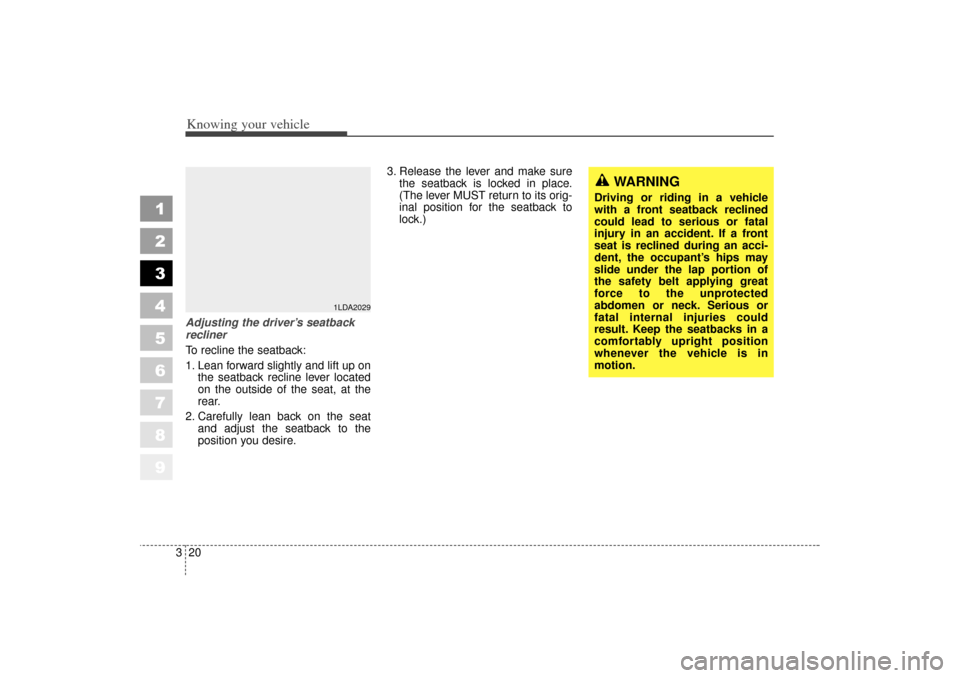
Knowing your vehicle20
3
1
2
3
4
5
6
7
8
9
Adjusting the driver’s seatback
recliner
To recline the seatback:
1. Lean forward slightly and lift up on
the seatback recline lever located
on the outside of the seat, at the
rear.
2. Carefully lean back on the seat and adjust the seatback to the
position you desire. 3. Release the lever and make sure
the seatback is locked in place.
(The lever MUST return to its orig-
inal position for the seatback to
lock.)
1LDA2029
WARNING
Driving or riding in a vehicle
with a front seatback reclined
could lead to serious or fatal
injury in an accident. If a front
seat is reclined during an acci-
dent, the occupant’s hips may
slide under the lap portion of
the safety belt applying great
force to the unprotected
abdomen or neck. Serious or
fatal internal injuries could
result. Keep the seatbacks in a
comfortably upright position
whenever the vehicle is in
motion.
LD CAN (ENG) new 3-1~.qxd 7/29/05 10:28 AM Page 20
Page 35 of 273
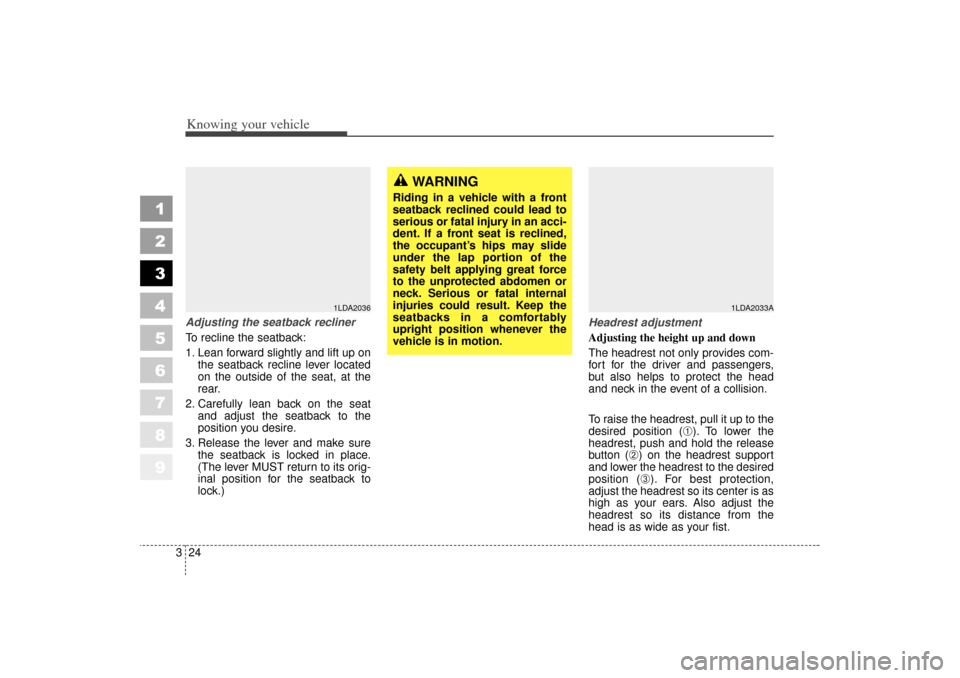
Knowing your vehicle24
3
1
2
3
4
5
6
7
8
9
Adjusting the seatback recliner
To recline the seatback:
1. Lean forward slightly and lift up on
the seatback recline lever located
on the outside of the seat, at the
rear.
2. Carefully lean back on the seat and adjust the seatback to the
position you desire.
3. Release the lever and make sure the seatback is locked in place.
(The lever MUST return to its orig-
inal position for the seatback to
lock.) Headrest adjustment
Adjusting the height up and down
The headrest not only provides com-
fort for the driver and passengers,
but also helps to protect the head
and neck in the event of a collision.
To raise the headrest, pull it up to the
desired position (
➀). To lower the
headrest, push and hold the release
button (
➁) on the headrest support
and lower the headrest to the desired
position (➂). For best protection,
adjust the headrest so its center is as
high as your ears. Also adjust the
headrest so its distance from the
head is as wide as your fist.
WARNING
Riding in a vehicle with a front
seatback reclined could lead to
serious or fatal injury in an acci-
dent. If a front seat is reclined,
the occupant’s hips may slide
under the lap portion of the
safety belt applying great force
to the unprotected abdomen or
neck. Serious or fatal internal
injuries could result. Keep the
seatbacks in a comfortably
upright position whenever the
vehicle is in motion.
1LDA2036
1LDA2033A
LD CAN (ENG) new 3-1~.qxd 7/29/05 10:28 AM Page 24
Page 36 of 273

325
1
2
3
4
5
6
7
8
9
Knowing your vehicle
Removal
To remove the headrest, raise it as
far as it can go then press the
release button (
➀) while pulling
upward (
➁).
Rear seat Split folding rear seat (if equipped)
The rear seatbacks fold forward to
provide additional cargo space and
to provide access to the cargo area.
To fold the rear seatback(s) down, pull the lock release lever, then fold
the seatback forward and down.
To raise the seatback, lift and push it firmly until it clicks into place.
When you return the seatback to its upright position, reposition the
rear safety belts so that they can
be used by rear seat passengers.
4 Door (if equipped)
1. Pull the lock release lever.
2. Move the rear center three-pointseat belts (if equipped) to the out-
side (
➀) so that they don’t interfere
with the seatback when lowering.
3. Fold the seatback forward and down firmly (
➁).
1LDA2034A
WARNING
To reduce the risk of head and
neck injuries, do not drive the
vehicle with the headrest
removed or improperly posi-
tioned.
1LDN20381LDN3025
LD CAN (ENG) new 3-1~.qxd 7/29/05 10:28 AM Page 25
Page 38 of 273
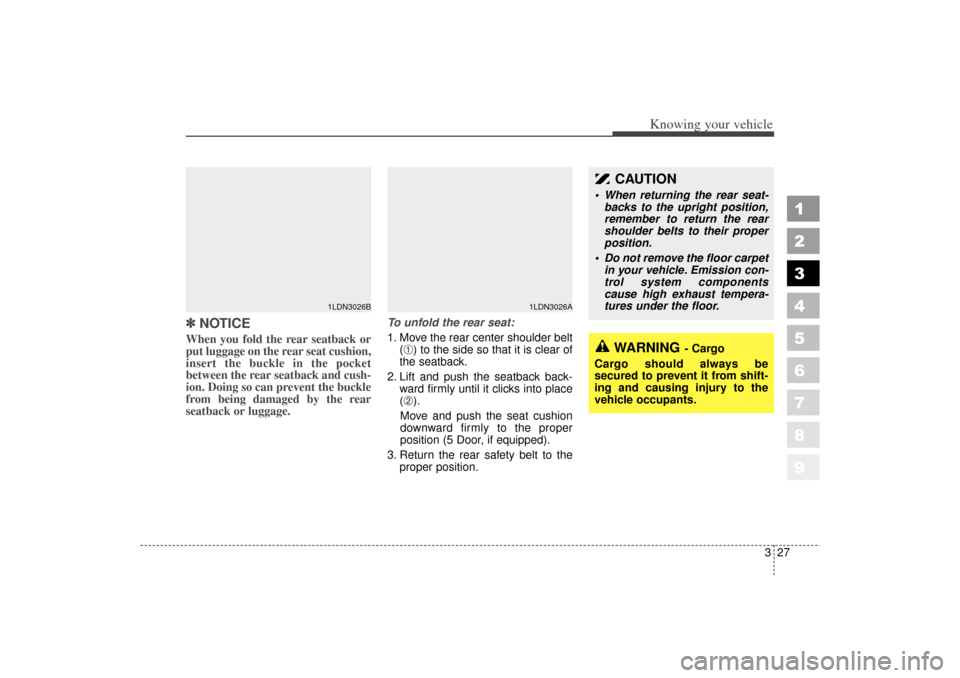
327
1
2
3
4
5
6
7
8
9
Knowing your vehicle
✽ ✽NOTICEWhen you fold the rear seatback or
put luggage on the rear seat cushion,
insert the buckle in the pocket
between the rear seatback and cush-
ion. Doing so can prevent the buckle
from being damaged by the rear
seatback or luggage.
To unfold the rear seat:
1. Move the rear center shoulder belt
(
➀) to the side so that it is clear of
the seatback.
2. Lift and push the seatback back- ward firmly until it clicks into place
(➁).
Move and push the seat cushion
downward firmly to the proper
position (5 Door, if equipped).
3. Return the rear safety belt to the proper position.
1LDN3026A
1LDN3026B
CAUTION
When returning the rear seat-backs to the upright position,
remember to return the rear
shoulder belts to their proper
position.
Do not remove the floor carpet in your vehicle. Emission con-
trol system components
cause high exhaust tempera-
tures under the floor.
WARNING
- Cargo
Cargo should always be
secured to prevent it from shift-
ing and causing injury to the
vehicle occupants.
LD CAN (ENG) new 3-1~.qxd 7/29/05 10:28 AM Page 27
Page 40 of 273
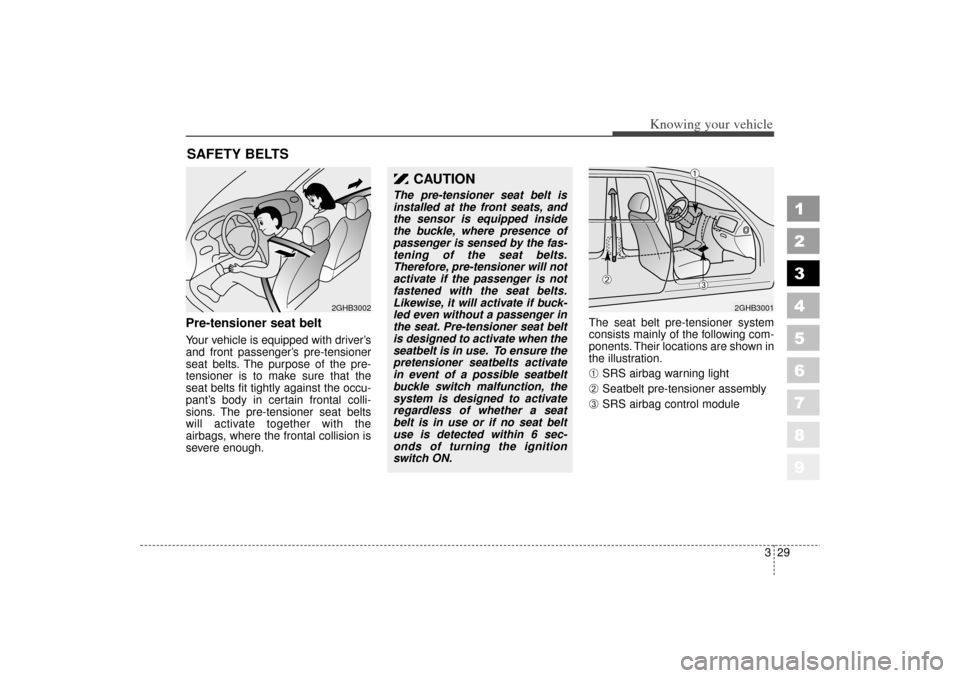
329
1
2
3
4
5
6
7
8
9
Knowing your vehicle
Pre-tensioner seat beltYour vehicle is equipped with driver’s
and front passenger’s pre-tensioner
seat belts. The purpose of the pre-
tensioner is to make sure that the
seat belts fit tightly against the occu-
pant’s body in certain frontal colli-
sions. The pre-tensioner seat belts
will activate together with the
airbags, where the frontal collision is
severe enough.The seat belt pre-tensioner system
consists mainly of the following com-
ponents. Their locations are shown in
the illustration.
➀
SRS airbag warning light
➁
Seatbelt pre-tensioner assembly
➂
SRS airbag control module
SAFETY BELTS
2GHB3002
CAUTION
The pre-tensioner seat belt is
installed at the front seats, and
the sensor is equipped inside
the buckle, where presence of
passenger is sensed by the fas-
tening of the seat belts.
Therefore, pre-tensioner will not
activate if the passenger is not
fastened with the seat belts.
Likewise, it will activate if buck-
led even without a passenger in
the seat. Pre-tensioner seat belt
is designed to activate when the
seatbelt is in use. To ensure the
pretensioner seatbelts activate
in event of a possible seatbelt
buckle switch malfunction, the
system is designed to activate
regardless of whether a seat
belt is in use or if no seat belt
use is detected within 6 sec-
onds of turning the ignition
switch ON.
2GHB3001
➀
➁
➂
LD CAN (ENG) new 3-1~.qxd 7/29/05 10:28 AM Page 29
Page 41 of 273
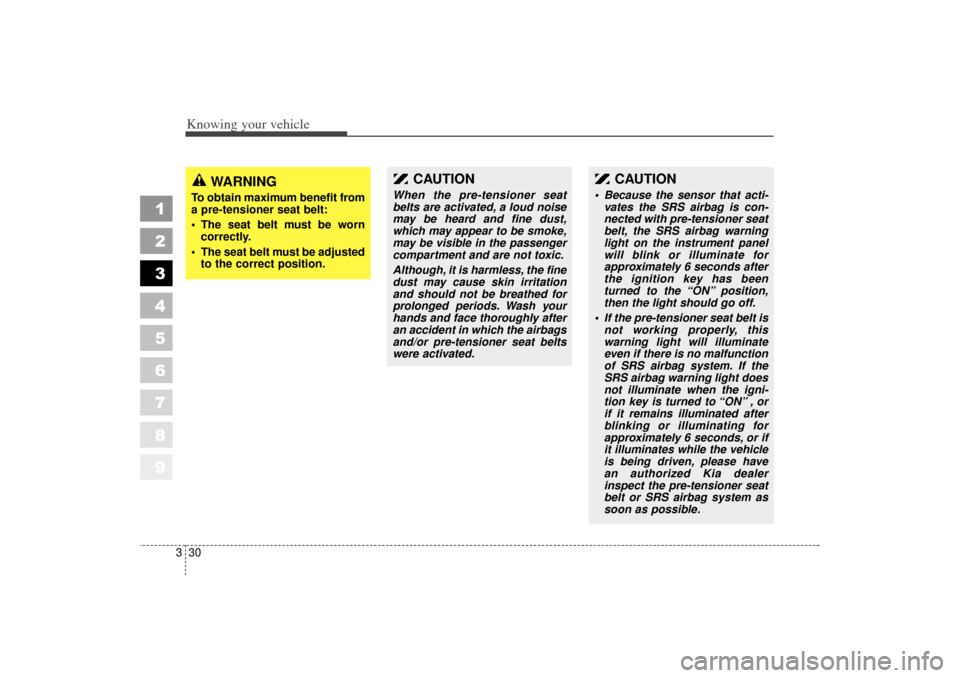
Knowing your vehicle30
3
1
2
3
4
5
6
7
8
9
WARNING
To obtain maximum benefit from
a pre-tensioner seat belt:
The seat belt must be worn
correctly.
The seat belt must be adjusted to the correct position.
CAUTION
When the pre-tensioner seat
belts are activated, a loud noise
may be heard and fine dust,
which may appear to be smoke,
may be visible in the passenger
compartment and are not toxic.
Although, it is harmless, the fine
dust may cause skin irritation
and should not be breathed for
prolonged periods. Wash your
hands and face thoroughly after
an accident in which the airbags
and/or pre-tensioner seat belts
were activated.
CAUTION
Because the sensor that acti-vates the SRS airbag is con-
nected with pre-tensioner seat
belt, the SRS airbag warning
light on the instrument panel
will blink or illuminate for
approximately 6 seconds after
the ignition key has been
turned to the “ON” position,
then the light should go off.
If the pre-tensioner seat belt is not working properly, this
warning light will illuminate
even if there is no malfunction
of SRS airbag system. If the
SRS airbag warning light does
not illuminate when the igni-
tion key is turned to “ON” , or
if it remains illuminated after
blinking or illuminating for
approximately 6 seconds, or if
it illuminates while the vehicle
is being driven, please have
an authorized Kia dealer
inspect the pre-tensioner seat
belt or SRS airbag system as
soon as possible.
LD CAN (ENG) new 3-1~.qxd 7/29/05 10:28 AM Page 30
Page 42 of 273
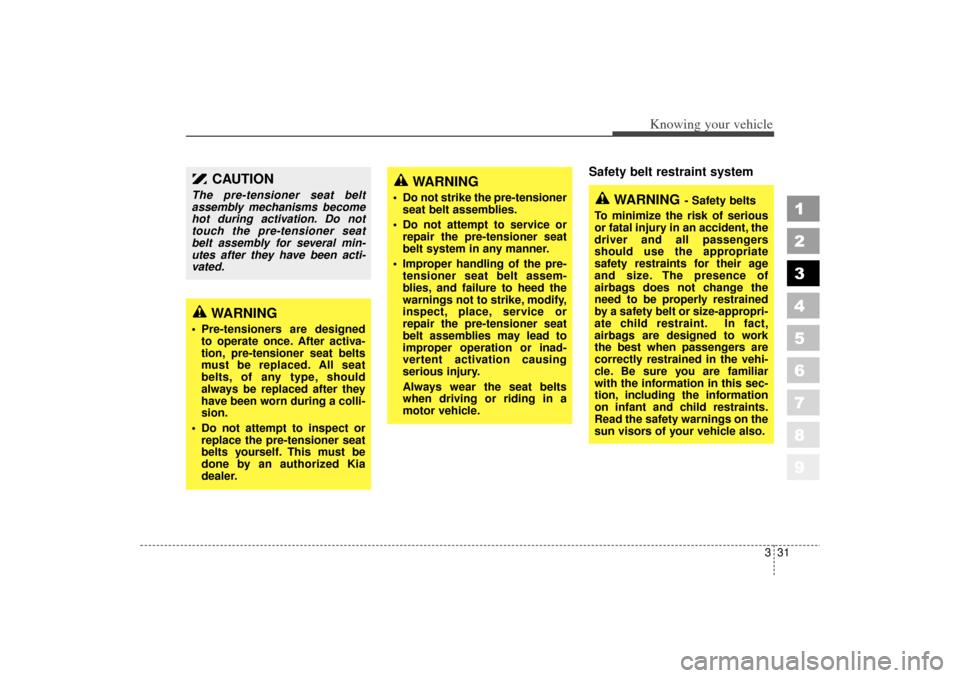
331
1
2
3
4
5
6
7
8
9
Knowing your vehicle
Safety belt restraint system
WARNING
Pre-tensioners are designedto operate once. After activa-
tion, pre-tensioner seat belts
must be replaced. All seat
belts, of any type, should
always be replaced after they
have been worn during a colli-
sion.
Do not attempt to inspect or replace the pre-tensioner seat
belts yourself. This must be
done by an authorized Kia
dealer.
CAUTION
The pre-tensioner seat belt
assembly mechanisms become
hot during activation. Do not
touch the pre-tensioner seat
belt assembly for several min-
utes after they have been acti-
vated.
WARNING
Do not strike the pre-tensionerseat belt assemblies.
Do not attempt to service or repair the pre-tensioner seat
belt system in any manner.
Improper handling of the pre- tensioner seat belt assem-
blies, and failure to heed the
warnings not to strike, modify,
inspect, place, service or
repair the pre-tensioner seat
belt assemblies may lead to
improper operation or inad-
vertent activation causing
serious injury.
Always wear the seat belts
when driving or riding in a
motor vehicle.
WARNING
- Safety belts
To minimize the risk of serious
or fatal injury in an accident, the
driver and all passengers
should use the appropriate
safety restraints for their age
and size. The presence of
airbags does not change the
need to be properly restrained
by a safety belt or size-appropri-
ate child restraint. In fact,
airbags are designed to work
the best when passengers are
correctly restrained in the vehi-
cle. Be sure you are familiar
with the information in this sec-
tion, including the information
on infant and child restraints.
Read the safety warnings on the
sun visors of your vehicle also.
LD CAN (ENG) new 3-1~.qxd 7/29/05 10:28 AM Page 31
Page 43 of 273
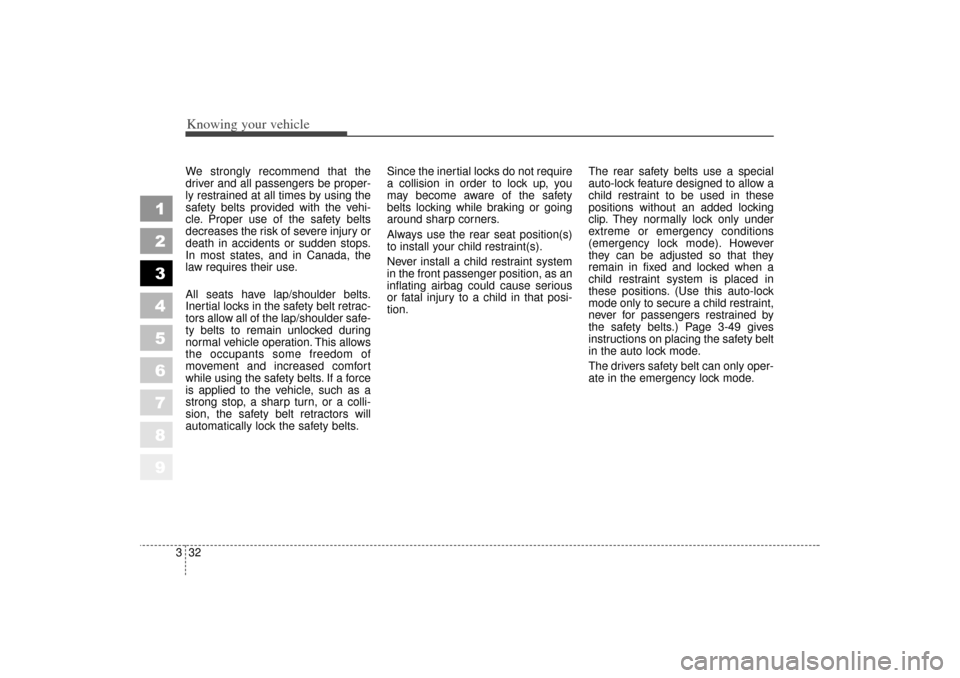
Knowing your vehicle32
3
1
2
3
4
5
6
7
8
9
We strongly recommend that the
driver and all passengers be proper-
ly restrained at all times by using the
safety belts provided with the vehi-
cle. Proper use of the safety belts
decreases the risk of severe injury or
death in accidents or sudden stops.
In most states, and in Canada, the
law requires their use.
All seats have lap/shoulder belts.
Inertial locks in the safety belt retrac-
tors allow all of the lap/shoulder safe-
ty belts to remain unlocked during
normal vehicle operation. This allows
the occupants some freedom of
movement and increased comfort
while using the safety belts. If a force
is applied to the vehicle, such as a
strong stop, a sharp turn, or a colli-
sion, the safety belt retractors will
automatically lock the safety belts. Since the inertial locks do not require
a collision in order to lock up, you
may become aware of the safety
belts locking while braking or going
around sharp corners.
Always use the rear seat position(s)
to install your child restraint(s).
Never install a child restraint system
in the front passenger position, as an
inflating airbag could cause serious
or fatal injury to a child in that posi-
tion.
The rear safety belts use a special
auto-lock feature designed to allow a
child restraint to be used in these
positions without an added locking
clip. They normally lock only under
extreme or emergency conditions
(emergency lock mode). However
they can be adjusted so that they
remain in fixed and locked when a
child restraint system is placed in
these positions. (Use this auto-lock
mode only to secure a child restraint,
never for passengers restrained by
the safety belts.) Page 3-49 gives
instructions on placing the safety belt
in the auto lock mode.
The drivers safety belt can only oper-
ate in the emergency lock mode.
LD CAN (ENG) new 3-1~.qxd 7/29/05 10:28 AM Page 32